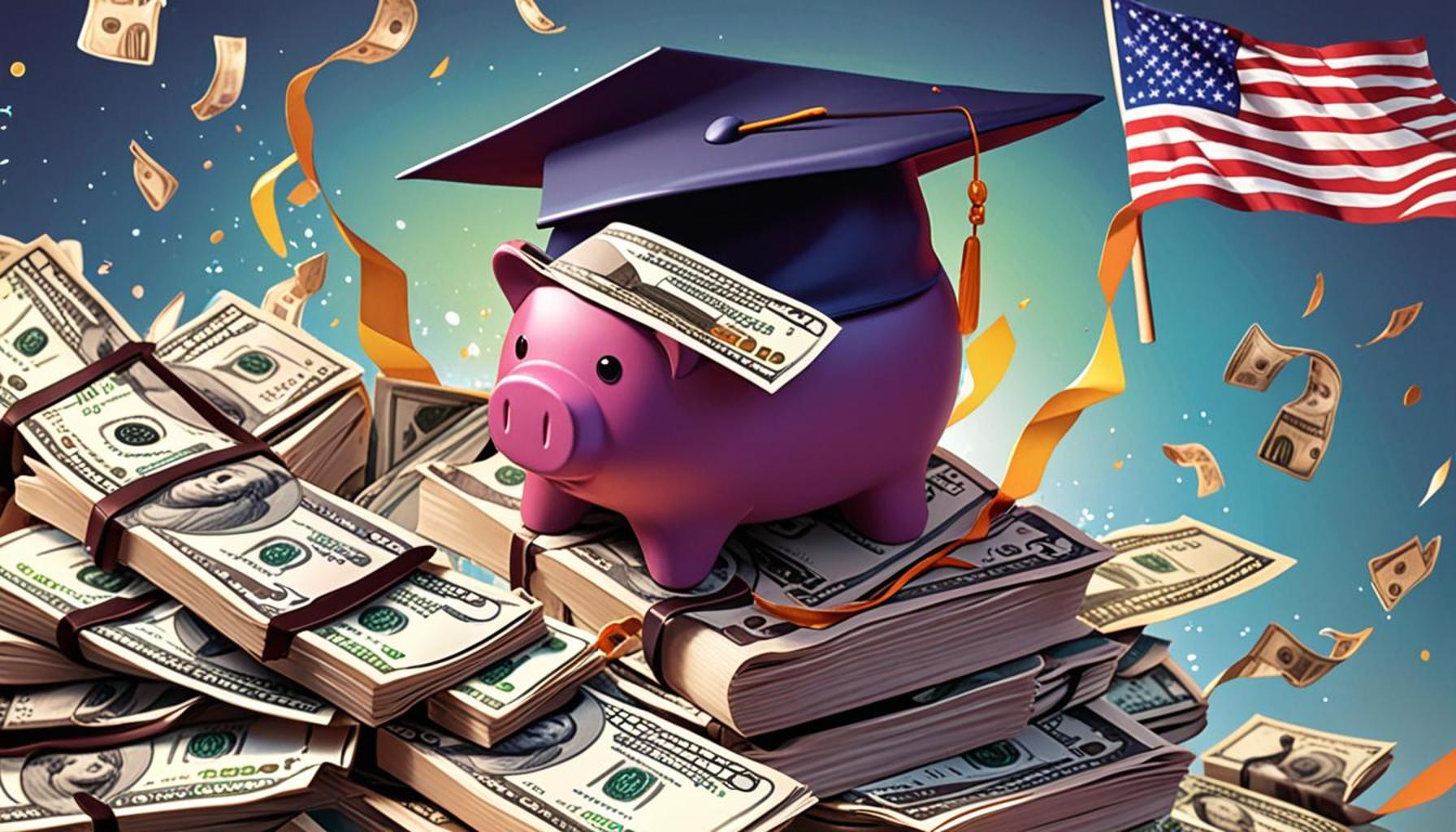The Role of Content Marketing in Education about Financial Aid for Students

The Role of Content Marketing in Financial Aid Education
In the quest for higher education, financial aid often plays a decisive role in making college accessible for many students. However, searching for financial assistance can present obstacles that deter students from pursuing their academic goals. With the complexities of applications, varying types of aid, and deadlines, the financial aid landscape can intimidate many. Here is where content marketing makes a significant impact, acting as a beacon of information amid the chaos.
Through tailored content, educational institutions and organizations are now taking proactive steps to demystify financial aid processes. Let’s explore some of the innovative strategies currently being implemented.
Engaging Articles
Informative articles play a crucial role in educating students about financial aid. For example, consider a piece that outlines the differences between federal loans and private loans. Such articles not only explain vital terms but also highlight common pitfalls to avoid. Institutions like the College Board have created extensive guides that cover step-by-step processes for applying for aid, ensuring that students are well-prepared and informed.
Video Tutorials
Visual learners particularly benefit from video tutorials, which break down essential topics related to financial aid in an engaging format. For instance, short videos that explain how to fill out the Free Application for Federal Student Aid (FAFSA) demystify a complex process. Channels dedicated to educational content on platforms such as YouTube have gained traction, with channels like “College Knowledge” offering clear instructions that can be accessed anytime, anywhere.
Social Media Campaigns
In an age where social media dominates communication, campaigns targeting young audiences have proven effective. Platforms like Instagram and TikTok have become hotbeds for sharing vital information on scholarships and funding opportunities. For example, a campaign might leverage trending hashtags to spread awareness about deadlines for state-funded scholarships, allowing information to circulate rapidly and widely.
Webinars
Interactive webinars provide an invaluable resource where students can engage with experts and ask their pressing questions in real time. These sessions often address topics ranging from how to write compelling scholarship essays to tips for negotiating financial aid packages. Notably, institutions like community colleges and universities have begun offering regular webinars, ensuring continuous support and guidance for students navigating financial decisions.
By leveraging these diverse formats, educational institutions are not just promoting financial aid but are actively working to democratize the information necessary for students to make informed choices. This shift leads to a more inclusive approach to education, where all students, regardless of socioeconomic background, have the opportunity to understand and access financial resources.
Understanding the impact of content marketing on financial aid education is essential for students today. It empowers them with the knowledge necessary to pursue their academic ambitions without the burden of financial uncertainty. As we look forward, it is clear that these effective content marketing strategies are not only enhancing education but also fostering financial literacy among the next generation of learners.
YOU MAY ALSO LIKE: Read read another article
Empowering Students Through Informative Resources
In an era where information overload is commonplace, the significance of content marketing in the education sector cannot be overstated, particularly in the context of financial aid. Effective content serves as a guide, aiding students in deciphering the often convoluted financial aid landscape. The role of content marketing extends beyond mere promotion; it creates an avenue for students to gain essential knowledge and navigate their financial options with confidence.
Interactive Infographics
Life as a student is often hectic, with tight schedules and competing priorities. This is where interactive infographics come into play. These visual tools condense vast amounts of information into easily digestible snippets that engage the user. For instance, an infographic displaying the timeline for applying for financial aid, along with application deadlines and requirements, can be a game-changer for prospective students. Resources provided by institutions such as the U.S. Department of Education are creating infographics that display vital financial aid facts in vibrant, accessible formats, making them not only informative but also visually appealing.
Success Stories and Testimonials
Nothing resonates more with students than real-life stories. Financial aid success stories shared through blogs and videos can spark hope and determination among prospective students. By highlighting how individuals overcame financial hurdles to achieve their academic goals, educational institutions create relatable narratives that demystify the uncertainty surrounding financial aid. Programs like “Scholarship Spotlight” or “Grant Success Stories” can be featured in newsletters or promotional campaigns, offering real-world examples of how financial assistance has made a tangible difference.
Targeted Email Campaigns
With the digital age allowing for sophisticated segmentation, targeted email campaigns can cater to specific demographics based on individual student needs. Institutions can develop tailored emails that provide personalized financial aid resources based on high school graduation dates, family income brackets, or expressed interests in specific college programs. Furthermore, using engaging subject lines that pique curiosity can significantly improve open rates. For example:
- “Unlock Your Future: Financial Aid Options Await!”
- “Don’t Miss Out: Critical Deadlines for Your Financial Aid Application”
- “Scholarships You Never Knew Existed!”
Such campaigns keep financial aid information at the forefront of students’ minds and encourage them to take actionable steps toward funding their education.
Accessible Online Resources
In today’s digital environment, having user-friendly online resources is vital. Educational institutions are increasingly developing comprehensive resource hubs where students can find everything from FAQs about FAFSA to interactive financial calculators. These resources serve as one-stop shops for clarifying doubts and fostering understanding of various types of aid, including scholarships, grants, work-study options, and loans. Being able to access this information at one’s convenience significantly lowers barriers to seeking financial help.
As students engage with these informative and relatable formats, they become empowered to make educated decisions regarding their financial futures. The integration of content marketing strategies in financial aid education not only enhances students’ comprehension of available resources but also fosters a culture of financial literacy that is essential for long-term success. Institutions that prioritize clear and creative content ultimately pave the way for students to pursue their educational dreams without the looming apprehension of financial constraints.
| Advantages of Content Marketing | Impact on Students |
|---|---|
| Increased Awareness | Content marketing aims to reach more students by creating informative articles and videos about financial aid options. |
| Engagement and Education | Interactive content can help students understand complex financial aid processes and make educated decisions. |
| Accessibility of Information | Content marketing makes financial resources easily accessible through blogs, social media, and dedicated websites. |
| Trust Building | By providing valuable, accurate information, organizations can establish credibility with students seeking financial assistance. |
In addition to the advantages presented in the table, content marketing plays a pivotal role in fostering relationships between educational institutions, financial aid organizations, and students. It serves as a bridge, connecting students to vital resources while demystifying the often daunting financial aid landscape. With carefully curated content, students not only gain valuable insights but also cultivate essential financial literacy skills, equipping them to navigate their academic journeys with greater confidence. Furthermore, organizations that effectively harness content marketing can respond in real-time to changing policies and resources, ensuring that students always have access to the latest information. This dynamic approach not only supports students but also contributes to a more educated populace prepared to manage their financial futures effectively.
ADDITIONAL INSIGHTS: Expand your understanding here
Building Community and Support Networks
The impact of content marketing extends beyond individual education; it cultivates a sense of community among students navigating the daunting landscape of financial aid. With the right content, institutions can facilitate discussions and foster connections that lead to a supportive environment for students seeking financial assistance.
Social Media Campaigns
Social media platforms have transformed the way knowledge is shared, allowing educational institutions to reach students where they are most active. By launching targeted social media campaigns, schools and universities can disseminate timely information about financial aid opportunities, application tips, and deadlines. Hashtags such as #FinancialAidFriday or #ScholarshipSundays create a buzz around financial aid topics, prompting students to engage, share, and ask questions. Institutions can also host live Q&A sessions on platforms like Instagram and Facebook, where financial aid officers answer real-time queries. This not only dispels misinformation but strengthens students’ confidence in navigating financial aid applications.
Webinars and Online Workshops
Live webinars and virtual workshops have gained traction as effective content marketing tools that provide in-depth information. These sessions offer students a chance to hear directly from experts and gain clarity about topics like navigating the FAFSA, understanding scholarships, and managing student loans. Institutions such as the College Board hold workshops that guide families through financial aid processes, emphasizing how to maximize available resources. In addition to providing valuable information, these interactive formats allow for participation and engagement, where students can voice their concerns directly to knowledgeable representatives.
Customized Content for Diverse Audiences
Recognizing that students come from various backgrounds with unique financial situations, educational institutions need to tailor their content. Creating customized materials—such as bilingual guides for non-English speakers or resources focused on underrepresented demographics—ensures that all students have equitable access to critical information. For example, institutions could collaborate with local community organizations to distribute content that specifically addresses the financial aid needs of disadvantaged groups, fostering inclusivity and understanding. By ensuring that content marketing strategies consider the diversity of student populations, institutions can promote a more equitable approach to financial assistance.
Feedback and Continuous Improvement
Incorporating student feedback into content marketing strategies allows institutions to improve and adapt their offerings to better meet students’ needs. Surveys, polls, and interactive quizzes can help gather insights into what content resonated most, where students struggled, and what additional resources would be beneficial. Institutions can then utilize this data to refine their existing content and develop new topics and materials that align with student interests. For example, if students express confusion around certain funding sources, institutions can quickly produce targeted articles or videos addressing those specific queries, enhancing their content’s effectiveness and relevance.
Such strategies demonstrate the pivotal role that content marketing plays not only in informing students about financial aid but also in strengthening their community connections and support networks. By leveraging today’s digital tools and focusing on collaboration, educational institutions can empower students to champion their education through an informed and proactive approach to financing their academic journeys.
ADDITIONAL INSIGHTS: Expand your understanding here
Conclusion
In today’s fast-paced digital landscape, the role of content marketing in educating students about financial aid cannot be overstated. Through strategic use of diverse platforms—ranging from social media campaigns to interactive webinars—educational institutions are able to break down complex financial processes into manageable, engaging formats. This approach not only demystifies financial aid but also empowers students to take charge of their educational funding paths.
Moreover, by creating customized content that speaks to the needs of diverse student populations, institutions can foster inclusivity and ensure that all students have access to essential financial resources. Such tailored strategies contribute not only to individual understanding but also to community cohesion, as students can connect with peers facing similar challenges. This shared experience strengthens support networks, which is vital in the often-overwhelming world of financial aid.
Additionally, by encouraging a cycle of feedback and continuous improvement, institutions can remain agile and responsive to the evolving needs of their student bodies. With an emphasis on relevant, up-to-date information delivered in accessible formats, financial aid resources can be easily navigated by all, further cultivating a financially literate generation.
Ultimately, the effective use of content marketing serves as a bridge connecting students to opportunities that might otherwise remain obscured by jargon and complexity. By empowering students with knowledge, educational institutions are not just facilitating access to financial aid; they are investing in a brighter, more informed future for all learners. It is through such endeavors that the essence of education—expanding minds and opening doors—truly flourishes.


